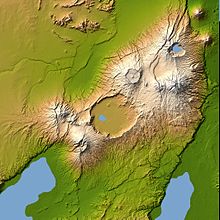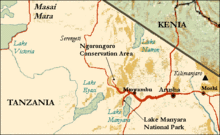Ngorongoro
| Ngorongoro Conservation Area | |
|---|---|
|
UNESCO world heritage |
|

|
|
| Herd of animals in the crater |
|
| National territory: |
|
| Type: | mixed |
| Criteria : | (iv) (vii) (viii) (ix) (x) |
| Surface: | 809,440 ha |
| Reference No .: | 39bis |
| UNESCO region : | Africa |
| History of enrollment | |
| Enrollment: | 1979 ( session 3 ) |
| Extension: | 2010 |
| Red list : | 1984-1989 |

Ngorongoro is a collapse crater in Tanzania on the edge of the Serengeti . It was created when a volcanic mountain collapsed at this point . The crater floor is at around 1700 m and the side walls are between 400 and 600 meters high, so that the crater edge is at around 2300 m . The diameter of the crater is between 17 and 21 kilometers. In total, the crater has an area of 26,400 hectares.
history
The Ngorongoro and the surrounding savannah highlands have been populated by Maasai herding nomads since the 18th century at the latest and used for nomadic pastoralism. The crater itself had great spiritual significance for the Maasai, among other things the Lerai Forest on the crater floor was used as a burial place. When the Austrian explorer Oskar Baumann visited the crater in 1892, it was populated by Maasai; also when the farmer Adolf Siedentopf applied for land in the crater from the German colonial government in 1904 in order to practice cattle breeding and agriculture in Ngorongoro. Siedentopf's application was granted, and a few years later his brother Friedrich Wilhelm also settled in the crater as a settler. The Maasai in Ngorongoro were forcibly resettled to a reserve south of Kilimanjaro in 1907, with their land rights being withdrawn ; only a few were allowed to stay in the crater to assist the Siedentopfs in raising cattle. Between 1912 and 1914, the German colonial administration developed serious plans to declare the crater a nature reserve. However, it was not possible to get Siedentopf to give up his lease. Shortly before the outbreak of the First World War, the remaining land in the crater was also to be given to Boer settlers. Only the outbreak of the First World War prevented this measure. The Siedentopfs left the crater during the World War.
The crater has been part of the Serengeti National Park since 1951 . In 1959 a special protection area ( Ngorongoro Conservation Area ) was established outside the crater , in which the Maasai are allowed to settle and graze. Agriculture in the crater was finally banned in 1975. In 1979 it was added to the UNESCO list of world natural heritage and in 1981 it was designated a biosphere reserve . In addition, the crater was declared a World Heritage Site in 2010.
In a 2006 report to the World Heritage Committee, the park administration wrote that the number of tourists' vehicles in the crater was an increasing problem. There is considerable settlement pressure in the outer areas. In the past, illegal fields regularly had to be removed. Most recently, 60,000 shepherds with 350,000 head of cattle were counted in the protected area. That is significantly more than the country can feed without the prohibited cultivation of grain. The situation should now be eased through the state purchase of land outside the park.
Climate and vegetation
Due to the different altitudes and the dynamics of the air masses, the local climate varies greatly. The high altitudes are mostly damp and hazy. The plains are subject to strong temperature fluctuations. The amount of rain falls in the months of November to April and also varies greatly depending on the location.
The edges of the crater are overgrown with bush and heathland , long grass savanna and remains of evergreen mountain forests . The crater floor is covered by short grass savannah, water holes and acacia forests .
Wildlife
About 25,000 large mammals populate the crater, including the highest density of predators in Africa. The number of zebras , buffalo , wildebeest , eland and Grant's and Thomson's gazelles is particularly large . They are hunted by lions , spotted hyenas and leopards . There are also elephants and, unusual in this area, hippos in the crater . There are still between ten and 15 specimens of the endangered black rhinoceros , the population of which was over a hundred in the 1960s. The great animal migrations in the Serengeti also lead through the Ngorongoro Crater.
Ngorongoro Nature Reserve
With its 8200 km² it covers large parts of the crater highlands, including the mountains Makerut and Oldeani with height of 3130 and 3188 m. In the west near the Serengeti the annual precipitation is 700 mm, in the highlands against it up to 1400 mm. There are rarely more than a few dozen elephants in the Ngorongoro Crater itself , but further elephant populations of uncertain size live on the outer slopes of the crater and in the highlands, especially in the mountain forest. In 1981 there were still 8,288 elephants in the sanctuary, in 1987 their number had dropped to 250.
Others
Michael Grzimek († 1959) and his father Bernhard Grzimek († 1987) were buried on the edge of the crater . In the early 1960s, Bernhard Grzimek, with funds from the Frankfurt Zoological Society , initiated the Serengeti Research Institute , which was supposed to research the migration routes and behavior of wild animals and thus contribute to their long-term protection.
Web links
- Entry on the UNESCO World Heritage Center website ( English and French ).
- Ngorongoro. Noah's crater , near Treasures of the World , with RealPlayer video, 14 min.
Individual evidence
- ↑ Daniela Eiletz-chewing, Sabine Jorke, Steffi Kordy: Kenya. Tanzania. Zanzibar . DuMont Reiseverlag, 2007, ISBN 377017660X limited preview in the Google book search
- ^ Bernhard Gissibl: The Nature of German Imperialism. Conservation and the Politics of Wildlife in colonial East Africa. New York / Oxford 2016.
- ^ Wally and Horst Hagen: The African national parks as habitats for elephants . In: Vitus B. Dröscher : Save the elephants of Africa . 1st edition. Goldmann Verlag , Munich 1992, ISBN 3-442-12322-4 . P. 239.
- ↑ Florian Schiegl: Ngorongoro Crater: On a large picture hunt in Grzimek's paradise. In: raushier-reisemagazin.de. July 20, 2011, accessed December 29, 2014 .
Coordinates: 3 ° 11 ′ S , 35 ° 34 ′ E







